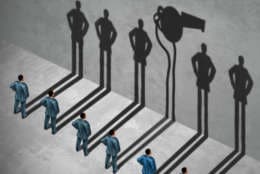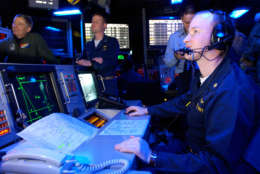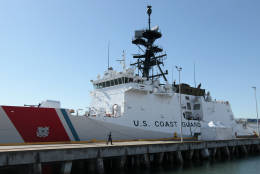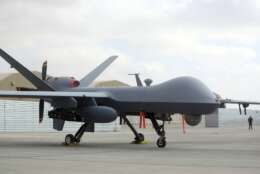Defense
-
For smaller suppliers, selling to DoD still isn't a walk in the park – but things are getting a little simpler. Last month, the department enacted a long-awaited rule change that prohibits prime contractors from flowing unnecessary contract clauses down to their subcontractors. It is all a part of more changes that are meant to simplify commercial buying in DoD that are still in the rulemaking pipeline. Dan Ramish is counsel at the law firm Haynes & Boone. He talked with Federal News Network’s Deputy Editor Jared Serbu about what the changes mean.
December 06, 2023 -
The Senate in a single stroke has approved about 425 military promotions after Sen. Tommy Tuberville of Alabama ended a monthslong blockade of nominations over a Pentagon abortion policy. Tuberville had been under pressure from members of both sides of the political aisle to end his holds as senators complained about the toll it was taking on service members and their families, and on military readiness. Tuberville said holds would continue, however, for about 11 of the highest-ranking military officers. President Joe Biden calls the Senate’s action long overdue and says the military confirmations should never have been held up.
December 05, 2023 -
David Drabkin, a fellow at the Stevens Institute of Technology Acquisition Innovation Research Center, and Chris Yukins, a professor at the George Washington University law school and a fellow with Acquisition Innovation Research Center, led a review of DoD’s protest data, specifically focused on agency-level complaints.
December 05, 2023 -
The MITRE Corporation is celebrating the opening of what it says will help numerous federal agencies do a better job of studying national security, climate and environmental issues. The new BlueTech Lab in Bedford, Massachusetts opened its doors to federal agency sponsors last month. It includes a 620,000-gallon tank for testing unmanned surface and undersea systems – the biggest in the region.
December 04, 2023 -
here has been a significant achievement for DoD’s Space Development Agency. Last month, SDA demonstrated it could use a communication system called Link 16 between ground stations and its new network of low-earth orbiting satellites. It is the first time the ubiquitous military communication protocol has ever been used in space. For more on why that matters and what it means, Federal News Network Deputy Editor Jared Serbu talked with Jennifer Elzea, SDA's Director of Strategic Engagement on the Federal Drive with Tom Temin.
December 04, 2023 -
The VA’s Office of Accountability and Whistleblower Protection (OAWP) – set up in the aftermath of the department’s secret wait-list scandal – got off to a very rocky start. It had scandals of its own. According to the government watchdog Project on Government Oversight (POGO), VA has reformed OAWP in ways that have made real progress toward building whistleblower confidence. But there is still a whole lot of work to do. Joe Spielberger is policy counsel at POGO. A few weeks ago, he testified before the House Veterans Affairs Committee about what is needed at OAWP. He speaks here with Federal News Network Deputy Editor Jared Serbu.
December 01, 2023 -
In today's Federal Newscast: GSA's Inspector General will scrutinize the decision to relocate the FBI HQ to Greenbelt, Maryland. Gen. CQ Brown spells out the dangers of a year-long CR, from his perch as Joint Chiefs Chairman. And the Merit Systems Protection Board is close to filling the final spot on its three-member panel.
December 01, 2023 -
The National Maritime Intelligence-Integration Office coordinates maritime awareness intelligence from a plethora of stakeholders, both domestic and international, and employs cloud services and automation tools to make sense of it all.
November 30, 2023 -
In today's Federal Newscast: The Cyber Accreditation Body has a new leader. The Department of Veterans Affairs has surpassed its goal to permanently house homeless veterans. And SmartPay celebrates its 25th anniversary with a facelift of its website.
November 30, 2023 -
The Department of the Air Force needs to work on several areas to meet its modernization and transformation goals, including improving data quality and accessibility, complying with set DoD standards, retiring legacy systems and thinking about how it can improve to meet its future needs.
November 29, 2023 -
The Coast Guard is one of the smallest military services -- but it has a big mission. According to the Government Accountability Office, it is still struggling to meet that mission because of longstanding challenges in at least three major areas. To talk through where things stand and how the service can improve, Federal News Network's Deputy Editor Jared Serbu spoke with Heather MacLeod, GAO's Director for Homeland Security and Justice Issues.
November 29, 2023 -
The Navy’s submarine talent pipeline program will help address workforce shortages by working with industry at a time of increased demand for submarines with the United States’ partnership with Australia and the United Kingdom.
November 28, 2023 -
Our readers in Japan respond to a recent Federal News Network interview with the director of the Defense Health Agency -- telling us the civilian employee health care crisis in that country is far from resolved.
November 28, 2023 -
Talk about joint service. A member of the Space Force has become the first guardian to receive a service medal from the Coast Guard. The guardian spent three weeks aboard the Coast Guard Cutter Healy in the Arctic.
November 28, 2023 -
While the Defense Department’s Replicator program will be successful if it is able to get 2,000 drones within two years, speakers at Georgetown University’s Center for Security and Emerging Technology said that the program will be more successful if this is not a one-time thing. DoD must replicate this initiative in the future whether it is with new drones or another technology to help move beyond the valley of death.
November 27, 2023
















